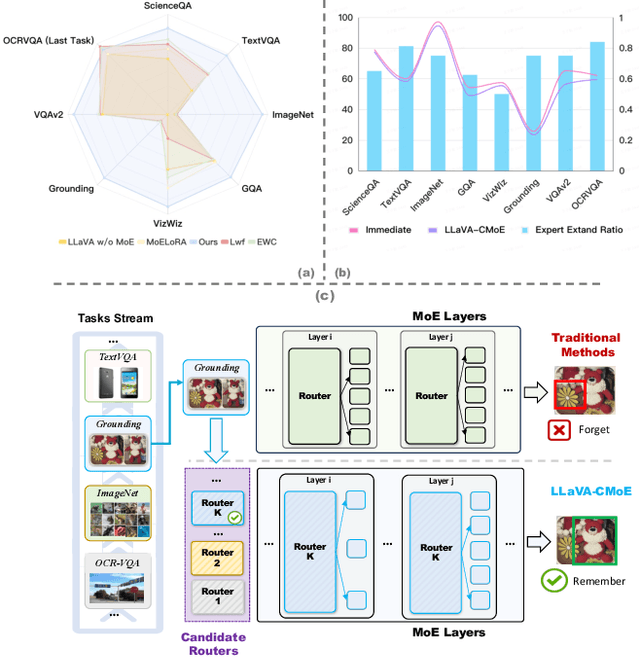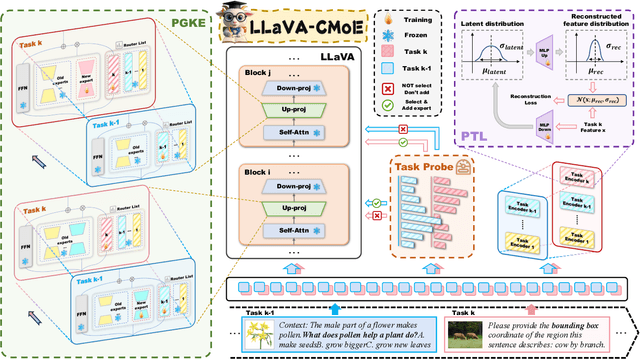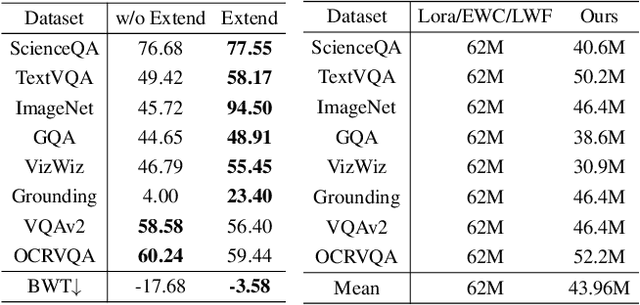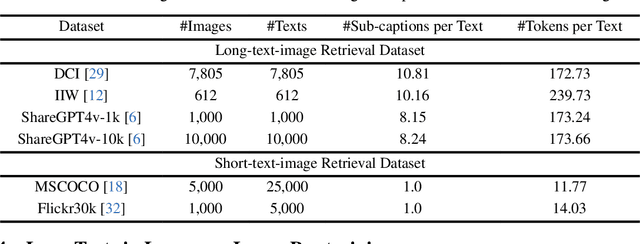Qingpei Guo
Ming-Omni: A Unified Multimodal Model for Perception and Generation
Jun 11, 2025Abstract:We propose Ming-Omni, a unified multimodal model capable of processing images, text, audio, and video, while demonstrating strong proficiency in both speech and image generation. Ming-Omni employs dedicated encoders to extract tokens from different modalities, which are then processed by Ling, an MoE architecture equipped with newly proposed modality-specific routers. This design enables a single model to efficiently process and fuse multimodal inputs within a unified framework, thereby facilitating diverse tasks without requiring separate models, task-specific fine-tuning, or structural redesign. Importantly, Ming-Omni extends beyond conventional multimodal models by supporting audio and image generation. This is achieved through the integration of an advanced audio decoder for natural-sounding speech and Ming-Lite-Uni for high-quality image generation, which also allow the model to engage in context-aware chatting, perform text-to-speech conversion, and conduct versatile image editing. Our experimental results showcase Ming-Omni offers a powerful solution for unified perception and generation across all modalities. Notably, our proposed Ming-Omni is the first open-source model we are aware of to match GPT-4o in modality support, and we release all code and model weights to encourage further research and development in the community.
EvoMoE: Expert Evolution in Mixture of Experts for Multimodal Large Language Models
May 28, 2025Abstract:Recent advancements have shown that the Mixture of Experts (MoE) approach significantly enhances the capacity of large language models (LLMs) and improves performance on downstream tasks. Building on these promising results, multi-modal large language models (MLLMs) have increasingly adopted MoE techniques. However, existing multi-modal MoE tuning methods typically face two key challenges: expert uniformity and router rigidity. Expert uniformity occurs because MoE experts are often initialized by simply replicating the FFN parameters from LLMs, leading to homogenized expert functions and weakening the intended diversification of the MoE architecture. Meanwhile, router rigidity stems from the prevalent use of static linear routers for expert selection, which fail to distinguish between visual and textual tokens, resulting in similar expert distributions for image and text. To address these limitations, we propose EvoMoE, an innovative MoE tuning framework. EvoMoE introduces a meticulously designed expert initialization strategy that progressively evolves multiple robust experts from a single trainable expert, a process termed expert evolution that specifically targets severe expert homogenization. Furthermore, we introduce the Dynamic Token-aware Router (DTR), a novel routing mechanism that allocates input tokens to appropriate experts based on their modality and intrinsic token values. This dynamic routing is facilitated by hypernetworks, which dynamically generate routing weights tailored for each individual token. Extensive experiments demonstrate that EvoMoE significantly outperforms other sparse MLLMs across a variety of multi-modal benchmarks, including MME, MMBench, TextVQA, and POPE. Our results highlight the effectiveness of EvoMoE in enhancing the performance of MLLMs by addressing the critical issues of expert uniformity and router rigidity.
Ming-Lite-Uni: Advancements in Unified Architecture for Natural Multimodal Interaction
May 05, 2025Abstract:We introduce Ming-Lite-Uni, an open-source multimodal framework featuring a newly designed unified visual generator and a native multimodal autoregressive model tailored for unifying vision and language. Specifically, this project provides an open-source implementation of the integrated MetaQueries and M2-omni framework, while introducing the novel multi-scale learnable tokens and multi-scale representation alignment strategy. By leveraging a fixed MLLM and a learnable diffusion model, Ming-Lite-Uni enables native multimodal AR models to perform both text-to-image generation and instruction based image editing tasks, expanding their capabilities beyond pure visual understanding. Our experimental results demonstrate the strong performance of Ming-Lite-Uni and illustrate the impressive fluid nature of its interactive process. All code and model weights are open-sourced to foster further exploration within the community. Notably, this work aligns with concurrent multimodal AI milestones - such as ChatGPT-4o with native image generation updated in March 25, 2025 - underscoring the broader significance of unified models like Ming-Lite-Uni on the path toward AGI. Ming-Lite-Uni is in alpha stage and will soon be further refined.
From Mapping to Composing: A Two-Stage Framework for Zero-shot Composed Image Retrieval
Apr 25, 2025Abstract:Composed Image Retrieval (CIR) is a challenging multimodal task that retrieves a target image based on a reference image and accompanying modification text. Due to the high cost of annotating CIR triplet datasets, zero-shot (ZS) CIR has gained traction as a promising alternative. Existing studies mainly focus on projection-based methods, which map an image to a single pseudo-word token. However, these methods face three critical challenges: (1) insufficient pseudo-word token representation capacity, (2) discrepancies between training and inference phases, and (3) reliance on large-scale synthetic data. To address these issues, we propose a two-stage framework where the training is accomplished from mapping to composing. In the first stage, we enhance image-to-pseudo-word token learning by introducing a visual semantic injection module and a soft text alignment objective, enabling the token to capture richer and fine-grained image information. In the second stage, we optimize the text encoder using a small amount of synthetic triplet data, enabling it to effectively extract compositional semantics by combining pseudo-word tokens with modification text for accurate target image retrieval. The strong visual-to-pseudo mapping established in the first stage provides a solid foundation for the second stage, making our approach compatible with both high- and low-quality synthetic data, and capable of achieving significant performance gains with only a small amount of synthetic data. Extensive experiments were conducted on three public datasets, achieving superior performance compared to existing approaches.
LLaVA-CMoE: Towards Continual Mixture of Experts for Large Vision-Language Models
Mar 27, 2025



Abstract:Although applying Mixture of Experts to large language models for learning new tasks is widely regarded as an effective strategy for continuous learning, there still remain two major challenges: (1) As the number of tasks grows, simple parameter expansion strategies can lead to excessively large models. (2) Modifying the parameters of the existing router results in the erosion of previously acquired knowledge. In this paper, we present an innovative framework named LLaVA-CMoE, which is a continuous Mixture of Experts (MoE) architecture without any replay data. Specifically, we have developed a method called Probe-Guided Knowledge Extension (PGKE), which employs probe experts to assess whether additional knowledge is required for a specific layer. This approach enables the model to adaptively expand its network parameters based on task distribution, thereby significantly improving the efficiency of parameter expansion. Additionally, we introduce a hierarchical routing algorithm called Probabilistic Task Locator (PTL), where high-level routing captures inter-task information and low-level routing focuses on intra-task details, ensuring that new task experts do not interfere with existing ones. Our experiments shows that our efficient architecture has substantially improved model performance on the Coin benchmark while maintaining a reasonable parameter count.
SegAgent: Exploring Pixel Understanding Capabilities in MLLMs by Imitating Human Annotator Trajectories
Mar 11, 2025Abstract:While MLLMs have demonstrated adequate image understanding capabilities, they still struggle with pixel-level comprehension, limiting their practical applications. Current evaluation tasks like VQA and visual grounding remain too coarse to assess fine-grained pixel comprehension accurately. Though segmentation is foundational for pixel-level understanding, existing methods often require MLLMs to generate implicit tokens, decoded through external pixel decoders. This approach disrupts the MLLM's text output space, potentially compromising language capabilities and reducing flexibility and extensibility, while failing to reflect the model's intrinsic pixel-level understanding. Thus, we introduce the Human-Like Mask Annotation Task (HLMAT), a new paradigm where MLLMs mimic human annotators using interactive segmentation tools. Modeling segmentation as a multi-step Markov Decision Process, HLMAT enables MLLMs to iteratively generate text-based click points, achieving high-quality masks without architectural changes or implicit tokens. Through this setup, we develop SegAgent, a model fine-tuned on human-like annotation trajectories, which achieves performance comparable to state-of-the-art (SOTA) methods and supports additional tasks like mask refinement and annotation filtering. HLMAT provides a protocol for assessing fine-grained pixel understanding in MLLMs and introduces a vision-centric, multi-step decision-making task that facilitates exploration of MLLMs' visual reasoning abilities. Our adaptations of policy improvement method StaR and PRM-guided tree search further enhance model robustness in complex segmentation tasks, laying a foundation for future advancements in fine-grained visual perception and multi-step decision-making for MLLMs.
M2-omni: Advancing Omni-MLLM for Comprehensive Modality Support with Competitive Performance
Feb 26, 2025Abstract:We present M2-omni, a cutting-edge, open-source omni-MLLM that achieves competitive performance to GPT-4o. M2-omni employs a unified multimodal sequence modeling framework, which empowers Large Language Models(LLMs) to acquire comprehensive cross-modal understanding and generation capabilities. Specifically, M2-omni can process arbitrary combinations of audio, video, image, and text modalities as input, generating multimodal sequences interleaving with audio, image, or text outputs, thereby enabling an advanced and interactive real-time experience. The training of such an omni-MLLM is challenged by significant disparities in data quantity and convergence rates across modalities. To address these challenges, we propose a step balance strategy during pre-training to handle the quantity disparities in modality-specific data. Additionally, a dynamically adaptive balance strategy is introduced during the instruction tuning stage to synchronize the modality-wise training progress, ensuring optimal convergence. Notably, we prioritize preserving strong performance on pure text tasks to maintain the robustness of M2-omni's language understanding capability throughout the training process. To our best knowledge, M2-omni is currently a very competitive open-source model to GPT-4o, characterized by its comprehensive modality and task support, as well as its exceptional performance. We expect M2-omni will advance the development of omni-MLLMs, thus facilitating future research in this domain.
Referencing Where to Focus: Improving VisualGrounding with Referential Query
Dec 26, 2024



Abstract:Visual Grounding aims to localize the referring object in an image given a natural language expression. Recent advancements in DETR-based visual grounding methods have attracted considerable attention, as they directly predict the coordinates of the target object without relying on additional efforts, such as pre-generated proposal candidates or pre-defined anchor boxes. However, existing research primarily focuses on designing stronger multi-modal decoder, which typically generates learnable queries by random initialization or by using linguistic embeddings. This vanilla query generation approach inevitably increases the learning difficulty for the model, as it does not involve any target-related information at the beginning of decoding. Furthermore, they only use the deepest image feature during the query learning process, overlooking the importance of features from other levels. To address these issues, we propose a novel approach, called RefFormer. It consists of the query adaption module that can be seamlessly integrated into CLIP and generate the referential query to provide the prior context for decoder, along with a task-specific decoder. By incorporating the referential query into the decoder, we can effectively mitigate the learning difficulty of the decoder, and accurately concentrate on the target object. Additionally, our proposed query adaption module can also act as an adapter, preserving the rich knowledge within CLIP without the need to tune the parameters of the backbone network. Extensive experiments demonstrate the effectiveness and efficiency of our proposed method, outperforming state-of-the-art approaches on five visual grounding benchmarks.
DynFocus: Dynamic Cooperative Network Empowers LLMs with Video Understanding
Nov 19, 2024Abstract:The challenge in LLM-based video understanding lies in preserving visual and semantic information in long videos while maintaining a memory-affordable token count. However, redundancy and correspondence in videos have hindered the performance potential of existing methods. Through statistical learning on current datasets, we observe that redundancy occurs in both repeated and answer-irrelevant frames, and the corresponding frames vary with different questions. This suggests the possibility of adopting dynamic encoding to balance detailed video information preservation with token budget reduction. To this end, we propose a dynamic cooperative network, DynFocus, for memory-efficient video encoding in this paper. Specifically, i) a Dynamic Event Prototype Estimation (DPE) module to dynamically select meaningful frames for question answering; (ii) a Compact Cooperative Encoding (CCE) module that encodes meaningful frames with detailed visual appearance and the remaining frames with sketchy perception separately. We evaluate our method on five publicly available benchmarks, and experimental results consistently demonstrate that our method achieves competitive performance.
LoTLIP: Improving Language-Image Pre-training for Long Text Understanding
Oct 07, 2024



Abstract:Understanding long text is of great demands in practice but beyond the reach of most language-image pre-training (LIP) models. In this work, we empirically confirm that the key reason causing such an issue is that the training images are usually paired with short captions, leaving certain tokens easily overshadowed by salient tokens. Towards this problem, our initial attempt is to relabel the data with long captions, however, directly learning with which may lead to performance degradation in understanding short text (e.g., in the image classification task). Then, after incorporating corner tokens to aggregate diverse textual information, we manage to help the model catch up to its original level of short text understanding yet greatly enhance its capability of long text understanding. We further look into whether the model can continuously benefit from longer captions and notice a clear trade-off between the performance and the efficiency. Finally, we validate the effectiveness of our approach using a self-constructed large-scale dataset, which consists of 100M long caption oriented text-image pairs. It is noteworthy that, on the task of long-text image retrieval, we beat the competitor using long captions with 11.1% improvement (i.e., from 72.62% to 83.72%). We will release the code, the model, and the new dataset to facilitate the reproducibility and further research. The project page is available at https://wuw2019.github.io/lotlip.
 Add to Chrome
Add to Chrome Add to Firefox
Add to Firefox Add to Edge
Add to Edge